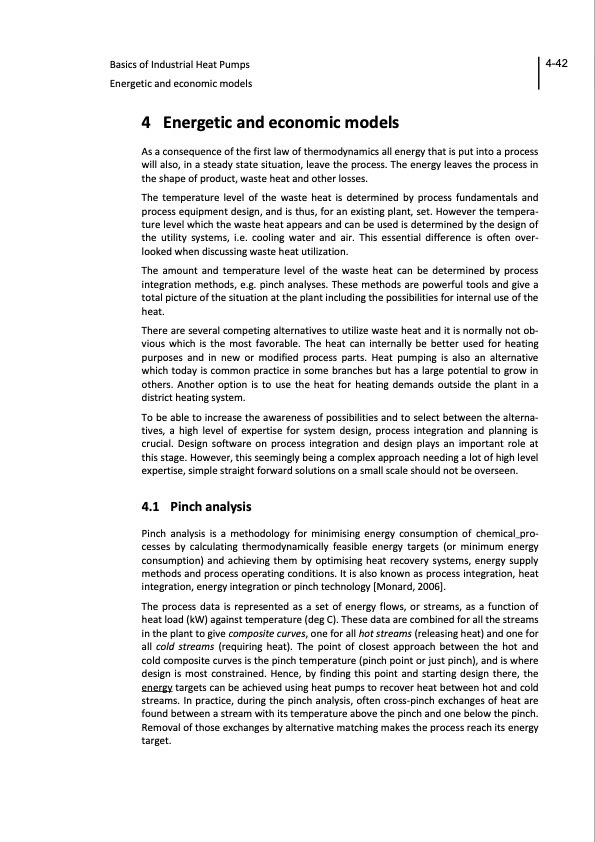
PDF Publication Title:
Text from PDF Page: 042
Basics of Industrial Heat Pumps 4-42 Energetic and economic models 4 Energetic and economic models As a consequence of the first law of thermodynamics all energy that is put into a process will also, in a steady state situation, leave the process. The energy leaves the process in the shape of product, waste heat and other losses. The temperature level of the waste heat is determined by process fundamentals and process equipment design, and is thus, for an existing plant, set. However the tempera- ture level which the waste heat appears and can be used is determined by the design of the utility systems, i.e. cooling water and air. This essential difference is often over- looked when discussing waste heat utilization. The amount and temperature level of the waste heat can be determined by process integration methods, e.g. pinch analyses. These methods are powerful tools and give a total picture of the situation at the plant including the possibilities for internal use of the heat. There are several competing alternatives to utilize waste heat and it is normally not ob- vious which is the most favorable. The heat can internally be better used for heating purposes and in new or modified process parts. Heat pumping is also an alternative which today is common practice in some branches but has a large potential to grow in others. Another option is to use the heat for heating demands outside the plant in a district heating system. To be able to increase the awareness of possibilities and to select between the alterna- tives, a high level of expertise for system design, process integration and planning is crucial. Design software on process integration and design plays an important role at this stage. However, this seemingly being a complex approach needing a lot of high level expertise, simple straight forward solutions on a small scale should not be overseen. 4.1 Pinch analysis Pinch analysis is a methodology for minimising energy consumption of chemical pro- cesses by calculating thermodynamically feasible energy targets (or minimum energy consumption) and achieving them by optimising heat recovery systems, energy supply methods and process operating conditions. It is also known as process integration, heat integration, energy integration or pinch technology [Monard, 2006]. The process data is represented as a set of energy flows, or streams, as a function of heat load (kW) against temperature (deg C). These data are combined for all the streams in the plant to give composite curves, one for all hot streams (releasing heat) and one for all cold streams (requiring heat). The point of closest approach between the hot and cold composite curves is the pinch temperature (pinch point or just pinch), and is where design is most constrained. Hence, by finding this point and starting design there, the energy targets can be achieved using heat pumps to recover heat between hot and cold streams. In practice, during the pinch analysis, often cross-pinch exchanges of heat are found between a stream with its temperature above the pinch and one below the pinch. Removal of those exchanges by alternative matching makes the process reach its energy target.PDF Image | Industrial Heat Pumps

PDF Search Title:
Industrial Heat PumpsOriginal File Name Searched:
annex-xiii-part-a.pdfDIY PDF Search: Google It | Yahoo | Bing
CO2 Organic Rankine Cycle Experimenter Platform The supercritical CO2 phase change system is both a heat pump and organic rankine cycle which can be used for those purposes and as a supercritical extractor for advanced subcritical and supercritical extraction technology. Uses include producing nanoparticles, precious metal CO2 extraction, lithium battery recycling, and other applications... More Info
Heat Pumps CO2 ORC Heat Pump System Platform More Info
| CONTACT TEL: 608-238-6001 Email: greg@infinityturbine.com | RSS | AMP |